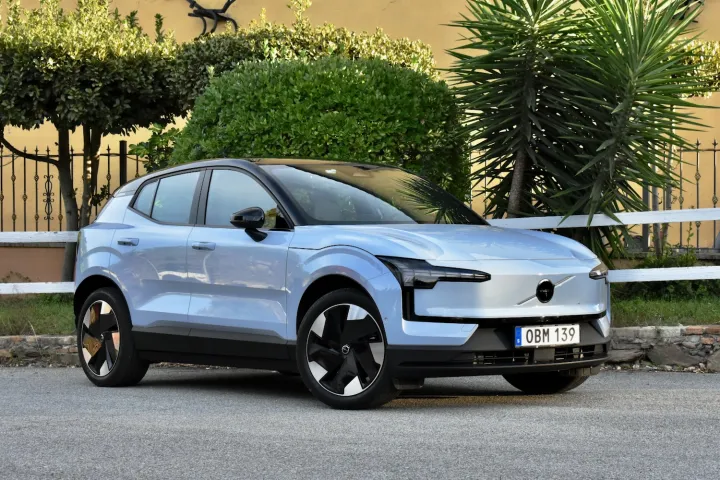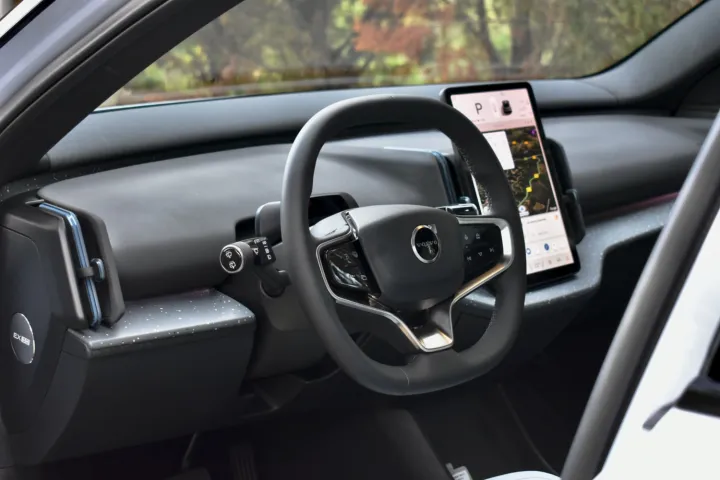
Automakers are quick to say that electric cars are the future, but most aren’t acting that way. In an effort to convince customers to overlook teething problems with charging infrastructure, amortize major investments in battery manufacturing as quickly as possible, and maybe replicate a bit of that Tesla magic, automakers have been emphasizing performance and tech gimmicks instead of what really matters: building cars people can afford. Change is coming, though, and from an unexpected source.
Volvo is known for safety and sensible Swedish design, not value. But the 2025 Volvo EX30 undercuts EVs from mainstream brands like Hyundai, Kia, and Volkswagen in price without compromising range, features, or style. Pricing starts at just $36,245 for the base Single Motor Extended Range Core model, and even the maxed-out price of $47,895 for a Twin Motor Performance Ultra looks inexpensive compared to the stratospheric heights some EV prices can reach when all option boxes are checked.
That emphasis on affordability could make the EX30 a game changer when it reaches dealerships in the United States next summer. But to truly make an impact, the EX30 has to be more than just a cheaper Volvo. It has to be a good car.
Design and interior

The exterior updates Volvo’s current minimal aesthetic. The grille-less front fascia and eight-bit lighting elements also appear on the larger Volvo EX90, but that model hasn’t gone on sale yet, so the EX30 looks truly fresh. A tall hood and upright roofline give the EX30 a degree of SUV presence (to be enhanced by a forthcoming Cross Country variant), but its small size and low overall height give it a car-like quality. It’s a look that’s hard to categorize, but still distinctively Volvo.
The EX30 isn’t just small for a Volvo. It’s 20.3 inches shorter than a Tesla Model Y, 15.8 inches shorter than a Hyundai Ioniq 5, and 13.8 inches shorter than a Volkswagen ID.4. However, it’s about as tall as these other EVs and thus offers comparable headroom in both rows (front-seat headroom is actually two inches greater than the Hyundai). The Volvo also comes close in first-row legroom, but its more compact proportions compromise rear legroom, which is appreciably less than the Hyundai, Tesla, or VW.
The EX30’s look is hard to categorize, but still distinctively Volvo.
The EX30’s small size becomes more apparent when looking at cargo space. This may be an SUV, but its 14.1 cubic feet of cargo space with the rear seats in place is less than what you get in a Nissan Leaf hatchback. Fold the second row and you get 31.9 cubic feet, about the same as a VW ID.4 offers with its rear seats up. And while Volvo did include a frunk, it’s really useful only for storing the charging cable.
The interior blends minimalism and cost savings. Volvo didn’t include an instrument cluster, moving the speedometer to the central touchscreen, the audio system has a sound-bar design with speakers mounted at the base of the windshield, and the window switches are mounted on the center console rather than the doors. This is an appropriately minimalist design for the product of a Scandinavian automaker, but it also likely helps Volvo hit the EX30’s relatively low price point. Other cool details include metal door pull rings that blend into the door trim, and available recycled materials like Particle Deco, a spackled material that looks a bit like linoleum countertop, but is actually made from recycled window frames.
Tech, infotainment, and driver assist

The EX30 comes standard with a 12.3-inch portrait-oriented touchscreen that, like other Volvo models, runs an Android-based infotainment system with Google Built-in features including Google Maps, Google Assistant, and Google Play. Wireless Apple CarPlay is included as well, while Android Auto is basically redundant because all major functions are already Google-based.
Volvo packed a lot of information onto the EX30’s screen. A top bar includes a speed readout and other information that would normally be shown on an instrument cluster. Google Maps occupies the middle of the screen, with control bars below similar to a computer’s home screen. Only instead of Microsoft Word, here you’ll find the climate controls, audio, and vehicle settings.
The touchscreen interface has a learning curve that’s steeper than others.
Considering how much needs to be done on the screen — even the mirrors need to be adjusted through the vehicle settings menu — operation is fairly smooth. As with other touchscreen interfaces, though, tapping the screen to adjust the temperature isn’t as easy as using a physical knob. And looking on the screen to find out the source of the latest driver-assist system chime takes some getting used to. Owners may get used to it, but this interface definitely has a learning curve that’s steeper than others.
Volvo is saving its most advanced driver-assist tech for more expensive models like the flagship EX90, but the EX30 still offers the basics. All models get standard blind spot monitoring, front and rear collision mitigation, a driver attention monitor, and a door-alert feature that warns the driver if they are about to open the door into the path of an oncoming vehicle or cyclist.
Volvo’s Pilot Assist system, which maintains speed, following distance, and lane positioning on highways (but still requires hands on the wheel and eyes on the road) is included on the top Ultra grade. This model also adds lane change assist, a 360-degree camera system with 3D view, and a park-assist system capable of maneuvering the EX30 into parking spaces with minimal driver involvement.
Driving experience

The EX30’s base rear-wheel drive Single Motor Extended Range powertrain is good for 268 horsepower and 253 pound-feet of torque. The all-wheel drive Twin Motor Performance is rated at 422 hp and 400 lb-ft of torque. Both have a 69-kilowatt-hour battery pack, although useable capacity is listed as 64 kWh. A smaller battery pack with a different chemistry will also be offered outside the U.S.
Volvo claims the Twin Motor Performance will do zero to 60 mph in 3.4 seconds in its screen-selectable Performance AWD mode. That’s the same as a Mercedes-AMG GLC63 S E Performance, a 671-hp thoroughbred from the German automaker’s AMG performance division. It’s also 0.1 second quicker than a Tesla Model Y Performance, which has a base price nearly $7,000 higher than the Volvo. And even the base single-motor version will reach 60 mph in a respectable 5.1 seconds.
The driving experience is comparable to more expensive Volvo models.
Improbably quick electric cars are nothing new, but the EX30 makes things even more fun thanks to its unassuming form. Tesla drivers are in for a surprise when they pull up next to one at a stop light. That being said, nothing else about the EX30 is as sporty as its acceleration. This is still a Volvo, and that means it has a laid-back driving experience that’s satisfying, but it won’t get your pulse racing.
Instead, the EX30 provides the solid feel and refined driving experience of more expensive Volvo models. It’s comfortable without being too soft and floaty and is impressively quiet (although wind noise does pick up a bit at higher speeds). Volvo also provides true one-pedal driving, allowing drivers to rely on regenerative braking instead of pushing the brake pedal in most situations, as well as the ability to turn it off for those who prefer an experience more like a gasoline car.
Range, charging, and safety

Official range ratings won’t be available until closer to the EX30’s summer 2024 arrival in the U.S., but Volvo estimates 275 miles for single-motor models and 265 miles for dual-motor models. As things currently sit, the base EX30 looks set to deliver more range than a base Tesla Model Y (260 miles), Hyundai Ioniq 5 (220 miles), or Volkswagen ID.4 (209 miles) at a lower price. Unless those brands increase range or lower prices in the coming months, that is.
The EX30 can DC fast charge at 153 kilowatts, delivering a 10% to 80% charge in 26.5 minutes, Volvo estimates. That’s adequate, but the EX30 lacks the high-power charging of the Ioniq 5 and other models based on its E-GMP platform, which can recover range more quickly.
Crash-test ratings will also have to wait until closer to launch. Expect the same four-year, 50,000-mile, basic warranty, four-year, 50,000-mile powertrain warranty, and an eight-year, 100,000-mile battery warranty as other Volvo EVs.
How DT would configure this car

The Twin Motor Performance will make headlines with its quick acceleration, but the Single Motor Extended Range is the most compelling EX30 model. It boasts 275 miles of range, is a bit more fun to drive thanks to a more responsive front end, and, aside from more power, doesn’t give up much in terms of features. Getting all available driver-assist features does require upgrading from the $36,245 Core trim level to the $41,895 Ultra, however.
Even with options, the EX30 looks pretty good compared to other small electric SUVs. The Volvo offers more range at a lower price than alternatives like the Hyundai Ioniq 5, Tesla Model Y, or Volkswagen ID.4 — and with the style and road manners of a true Volvo. From behind the wheel, the EX30 fulfills the promise of its brand, feeling like an upgrade over EVs from mainstream brands. It’s a less expensive car that doesn’t feel cheap.
The EX30’s relatively limited cargo space and quirky interior design might turn off some buyers. And because Volvo will build the EX30 in China (and also Belgium, in 2025), it won’t qualify for the $7,500 federal tax credit U.S.-assembled EVs like the Model Y and ID.4 can get, closing the price gap a bit. But Volvo’s new entry-level model is still a good car which, combined with its low base price, impressive range, and high level of feature content, makes it a game changer. The EX30 resets expectations for mainstream EVs.
Editors' Recommendations
- Volvo EX30 price, range, release date, specs, and more
- 2022 Volvo C40 Recharge first drive review: EV fashion statement
- Electrify America’s home station lets you charge your EV while watching Netflix


